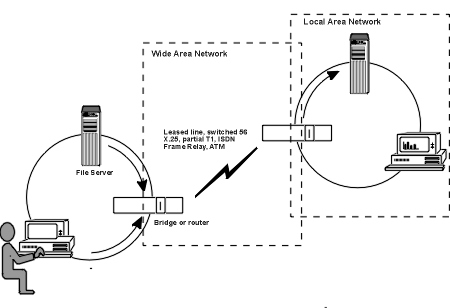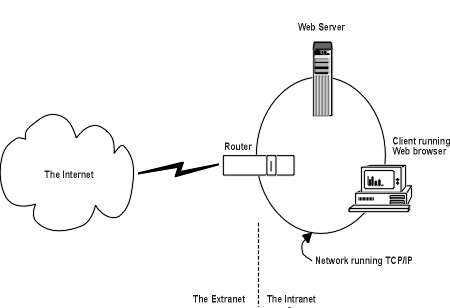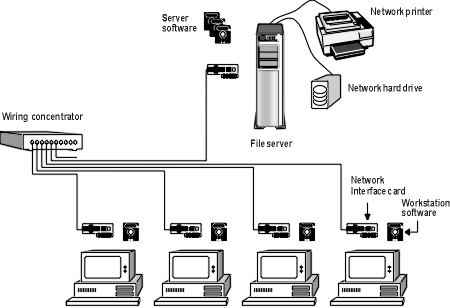Network Online Course
Lesson 1 - Network Basics
B. LAN vs. WAN
Local Area Network Definition
A communication system which is used to share hardware resources, programs and data files. It consists of the following:- the users
- their workstations and applications
- the network hardware which connects them
- the network software which controls the system
A Local Area Network (LAN) can connect many types of computing devices together such as microcomputers, minicomputers, mainframes, switches and routers. A LAN defines the reach of a network, not the devices attached to it. Basically a LAN extends as far as the LAN cable.
LAN characteristics:
- It is high capacity — 230.4Kbps (thousand bits per second) to 10Gbps (billion bits per second).
- It is local (works within a finite distance in a limited geographic area such as an office, building or complex of closely-spaced buildings). When physically remote computers, such as across the country, communicate, they are hooked together in a Wide Area Network (WAN).
- It usually uses cable (coaxial, twisted pair or fiber) but may use radio waves, infrared or micro waves.
- It is used by a single organization.
WANs
- Wide Area Networks
- Third party service provider
- Special interfaces to the WAN
- Less throughput than LAN
- Routing technology
Wide Area Networks
If a LAN ties computers together at a single site, than a WAN connects computers across large distances at multiple sites. Here are some important characteristics of wide area networks.- They use data lines which belong to a third party service provider such as the telephone company. Organizations do not create and use their own WANs.
- They requires special interfaces to the data lines such as synchronous modems, routers and/or DSU/CSUs. WANs do not use LAN cable systems.
- WANs have less throughput than LANs, therefore they require “gearing down” at the interface of the two systems. Routers decide which packets from the LAN will be transmitted over the WAN.
- Routing technology is a crucial component of a WAN. Routers decide how a packet should be sent in order that it arrive at its intended destination.

Figure 1: Wide Area Network
More networks
There are several kinds of networks which have different characteristics. They are usually known by their acronyms (first letter of each word). Since you may run across them in your network career, here is a short list.- MAN (Metropolitan Area Network)
A high speed (100Mbps, FDDI) network which spans city distances. For example, a large bank may put its data center in the suburbs where land is less expensive and yet still need to be in constant communications with head office, which is located downtown. - GAN (Global Area Network)
A network which spans the world. An example is the Internet. - EWAN (Enterprise Wide Area Network)
The network of a large multinational enterprise. It would use the services of numerous WAN providers, but to the employees of the company, it appears that the network is theirs. - FAN (Family Area Network)
LAN inside a home used to access the Internet.

Figure 2: An Intranet uses Internet technology
The Internet
The Internet is a special example of a WAN. The Internet is a network of networks that spans the globe. It is a cooperative system in which organizations voluntarily attach their networks to the Internet in order that their users can get the benefits of extensive communications. Although many different kinds of computers and networks are attached to the Internet, the following characteristics are always true.- The TCP/IP protocol suite is used. Network addresses are unique.
- The system uses a client/server computing architecture. This includes servers (Web, FTP, etc.) which provide the data or files, and clients (browsers, FTP, Telnet, etc.) which can make use of them.
Intranets
An intranet is an organization network which uses exactly the same technology as the Internet (TCP/IP, servers, browsers, etc.). The intranet coexists with the LAN system (Novell, Windows 2003, etc.) and even uses the same physical infrastructure (Ethernet, Token Ring, etc.).Sometimes an intranet is contrasted with an extranet, which is simply an external network. An extranet also implies privileged access, such as a company letting its customers into its internal inventory system to place an order.

Figure 3: Typical LAN components
LAN Components
The parts of a LAN are as follows:
- The File Server is the heart and soul of the network. It houses the hard disk which is shared by everyone and attached to it are printers which are also shared.
- Any machine which contributes resources to the network “serves” the network users. Therefore, it is know as a server. Examples include print servers, communication servers (“gateways”) and tape servers.
- The Network Operating System (NOS) is the software which runs in the server and controls the network.
- The users sit at the workstations to do their work. These are regular computers attached to the network. The workstations run regular desktop operating systems (Windows 98, 2000 Professional or XP) and in addition, workstation software, which enables the workstations to talk to the network.
- The physical connection to the network is made through a card, the Network Interface Card (NIC) which is installed inside every computer. Some networks also allow the cable to be attached to parallel or serial ports.
Exercise 1-2: LANs and WANS
1. Match up
Match up the following characteristics with the type of network. Place an L for LAN or W for WAN beside each one. Some characteristics apply to both types of networks.
__ Uses routers__ Limited distance
__ Uses third party service provider
__ Needs a special interface between networks
__ High capacity
__ Uses cable
2. Know your acronyms
Write out what each of the following acronyms means.
GANLAN
NIC
NOS
EWAN
Mbps
MAN
3. Explain the difference
Explain the difference between these terms.
Internet
Intranet
Extranet
[Top of page][On to next section]
